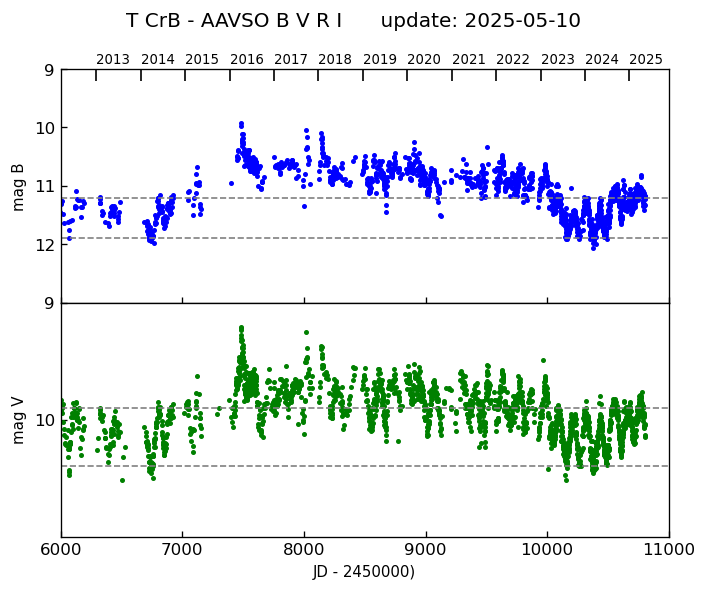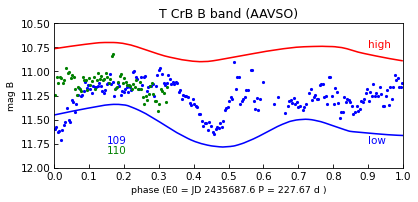Eruptive Stars
Monitoring
Recurrent Symbiotic Nova T CrB
(Pre Outburst spectroscopic monitoring: 2022 - 202X)
Context T CrB belongs to the very small group of recurring novae (RN) and among them the symbiotic sub-group (SyRN).
Its first outburst was detected in 1866 during which Huggins obtained the first spectrum of a nova. The second outburst occurred in 1946, making T CrB a recurring nova.
The system is currently in intermediate state after a "big active phase" from late 2014 to 2023-04 followed by a period of very activity.
From a comparison with 1946 event, Brad Scheafer (2019) predicted the next outburst around 2023. His last published prediction (2023) is April-September 2024 at one sigma confidence and before the end of 2024 at one sigma. Several others teams produced their own predictions. All the predictions based on analogy of the light curves failed.
Luna+ (2020) considering the lower activity of the very high state 2015-2023 delayed the prevision to 2023-2029 from an estimation of the accretion rate (analysis of X-rays spectra)
And: "The active phases are quasiperiodic and are not connected to the classical nova outbursts. "(K. Ilkiewicz, J. Mikolajewska, K. A. Stoyanov, 2023) .The nova outburst will happen when the mass of the accreted envelopp at the surface of the core of the white dwarf will be sufficient to trigger the energetic CNO reactions: in the current state of accumulation, there is no observable signal of the amount of accreted material: prediction is impossibe. The nova event may happen from now to a few years.
Current status (2025-05) Orbital variations, high state since January, 2025, declining.
Journal 2023 - 2025 May 2024: short flare of Balmer lines from JD 2460439.5 to 447.5 (+/- 0.5) . Flux (H alpha) reaches 8 E-12 erg/cm^2/s around JD 2460443.5 (+/- 0.5)
2024 November: detection of He II, He I and N III 4640 in a series of spectra secured by F. Sims, Leadbeater, R., Flo, J. Guarro, Shank, K.,Bertrand, E. (ATel #16912)
Update: 2025-05-10
Recent Spectrum Sepctrum secured by Keith Shank (R = 1000)
Medium intensity of Balmer lines with EW(H alpha) ~ 16
He I 5876 obvious
He II 4686 present but weakLast echelle spectrum
AAVSO
BV Bands
B and V luminosity according to the orbital phase.
The current cycle (110) in green.
Previous one in blue.blue line: mean luminosity before 2015 and 2023 (low state)
red line! min luminosity durin the very high state (2015/2023-04)Orbital Phase: Lines, 1988
P = 227.67 d
JD0= 2435687.6 ("conjunction with M3III behind")
Cleaned data, one day median
Spectroscopic
Evolution 2023-2025
2023-04: End of the "big active phase" 2023: very low activity 2024: increase of the activity.
2024-11: High ionisation state He II2024-11: High ionisation state He II
Flux H alpha from flux calibrated spectra
The ionization flare observed in November 2024
Spectroscopic
Evolution
2013-2023
One of the key feature of the evolution of the sytem during the high state 2015-2023 (big active phase, according the terminomogy suggested by Ielkiewicz+ 2016) is the intensity of He II 4686 line (see e.g. Ilkiewicz+, 2016)
The spectra acquired in 2023 show the fast decrease of He II.
The high cadency monitoring allows to detect precisely the stepped decrease of ionization on JD 2460048 +/- 6.
ATel#16109 T CrB: the active spectroscopic phase (2015-2023) is over
Eruptive Stars Database https://aras-database.github.io/database/tcrb.html Topic in ARAS Forum https://spectro-aras.com/forum/viewtopic.php?t=2902&start=30
Observers 2023- to date J.D. Hinnefeld, I. Diabassoura, F. Sims, A. Leduc, F. Teyssier, S. Curry, D. Boyd, D. Cujedo, J. Guarro Flo, C. Buil, G. Bertrand, E. Bertrand, X. Dupont, S. de Vischer, J. R. Foster, C. Boussin
R. Leabeater, C. Laulhère, J. Michelet, 2SPOT, K. Shank, V. Marie, V. Lecocq, C. Buil, G. Bertrand, +Observers 2012-2022 F. Sims, P. Somogyi, J. Guarro Flo, F. Teyssier, I. Diabassoura, D. Boyd, C. Boussin, P.A. Dubovsky, T. Lester, F. Campos, A. Leduc, K. Shank, V. Lecoq, S. Curry, , J.R. Foster J. Montier, L. Franco,
U. Sollecchia, C. Buil, K. Graham, V. Bouttard, T. Medulka, CDZ, J. Martin, J. Michelet, M. Rodriguez, R. Ehlert, P. Cazatto, O. Garde, F. Boubault, M. Verlinden, Y. Markus, P. Berardi,
S. de Visscher, X. Dupont, G. Bertrand, J. Coffin, M. Le Lain, C. Laulhere, R Ehlert, J.D. Hinnefeld, J. Lecomte, S. Charbonnel, G. Martineau, Y. Buchet, J.P. Godard, T. Rodda,
E. Bertrand, H. Boussier, J.B. Desrosiers, J.P. Masviel, D. Li, C. Revol, A.J. Wilson, C. Kreider
Monitoring:
Spectra T CrB Eruptive Stars Database (1720 spectra since 2012) : https://aras-database.github.io/database/tcrb.html
References:
Luna, G.J.M, Sokoloski J.L., Mukai K., and Kuin, N.P.M, 2020, ApJ https://arxiv.org/pdf/2009.11902.pdf
Iłkiewicz, K., Mikołajewska, J., Stoyanov, K., Manousakis, A., Miszalski, B., MNRAS, 2016 https://ui.adsabs.harvard.edu/abs/2016MNRAS.462.2695I/abstract
2023-2025
Binary Parameters for the Recurrent Nova T Coronae Borealis
Hinkle K. H. ; Nagarajan, P. ; Fekel, F. C. ; Mikołajewska J. ; Straniero O. ; Muterspaugh M. W.
The Astrophysical Journal, Volume 983, Issue 1, id.76, 16 pp.
T CrB: Detection of a Short Flare in 2024 November
Teyssier, F. ; Shore, S. N. ; Sims, F. ; Leadbeater, R. ; Flo, J. Guarro ; Shank, K. ; Bertrand, E. ; Foster, J. R.
Research Notes of the AAS, Volume 9, Issue 2, id.32
https://ui.adsabs.harvard.edu/abs/2025RNAAS...9...32T/abstract
https://arxiv.org/pdf/2307.00255.pdf
The "Super-Active" Accretion Phase of T CrB has Ended
Munari, Ulisse
Research Notes of the AAS, Volume 7, Issue 7, id.145.
ATel #16107 2023-06-30
https://www.astronomerstelegram.org/?read=16107
T CrB: the active spectroscopic state (2014-2023) is over
F. Teyssier, J. D. Hinnefeld, C. Boussin, I. Diabassoura , J. Guarro Flo, F. Sims, A. Leduc, S. Curry, D. Boyd, D. Cujedo (ARAS Group), S. N. Shore (Univ. of Pisa)
ATel #16114 2023-07-03
https://www.astronomerstelegram.org/?read=16114
Swift observations of the changes in the brightness of the recurrent nova T CrB
N Paul Kuin (MSSL), Gerardo Juan Manuel Luna (CONICET/ U. of Hurlingham), Kim Page (Leicester U), Koji Mukai (NASA/GSFC & UMBC), Jennifer L Sokoloski (Columbia U), Julian P. Osborne (Leicester U), Bradley E. Schaefer (Louisiana U)
ATel #16023 2023-04-30
https://www.astronomerstelegram.org/?read=16023
Strong flickering from the recurrent nova T Coronae Borealis ATel #16023
M. Minev, R. Zamanov, K. Stoyanov (Institute of Astronomy and NAO, Bulgarian Academy of Sciences)
ATel #15916 2023-02-28
https://www.astronomerstelegram.org/?read=15916
Persistent flickering of T CrB during the high activity state pre-nova outburst phase
S. N. Shore (Univ. Pisa), F. Teyssier (ARAS Group)



